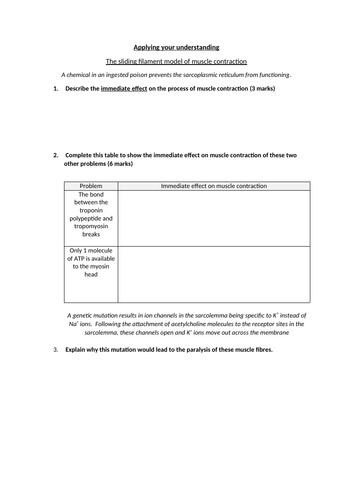




This is a fully-resourced lesson that covers the content of specification point 5.1.5 (l) of the OCR A-level Biology A specification which states that students should be able to demonstrate and apply their knowledge and understanding of the sliding filament model of muscular contraction. The wide range of activities included in the lesson will engage and motivate the students whilst the understanding and previous knowledge checks will not only allow them to assess their progress but also challenge them to make links to other Biology topics.
The lesson begins by using an idea from the quiz show POINTLESS to get them to recognise that myology is the study of muscles. This leads nicely into the next task, where they have to identify three further terms (from 12) which will also begin with myo and are the names of structures involved in the arrangement of skeletal muscle. Key terminology is used throughout the lesson so that students feel comfortable when they encounter this in questions. Students are introduced to the sarcomere and the bands and zones that are found within a myofibril so they can discover how most of these structures narrow but the A band, which is the length of the myosin filament, stays the same length between resting and contracted muscle. This has been designed to lead into a discussion point where they are encouraged to consider how the sarcomere can narrow but the lengths of the myofilaments can remain the same. The main task of the lesson involves the formation of a bullet point description of the sliding filament model where one event is the trigger for the next. Time is taken during this section to focus on the involvement of the calcium ions but also ATP and the idea of the sources of this molecule, including creatine phosphate, are discussed in more detail later in the lesson. The final part of the lesson involves students having to apply their knowledge by describing the effect on muscle contraction when a part of a structure is unable to function correctly.
This lesson has been designed for students studying the OCR A-level Biology course and ties in nicely with the other lessons on this particular topic such as neuromuscular junctions as well as the other uploaded lessons from module 5
Something went wrong, please try again later.
Thank you, this is a fantastic resource which I was able to easily adapted for an alternative syllabi, DP Biology.
Report this resourceto let us know if it violates our terms and conditions.
Our customer service team will review your report and will be in touch.